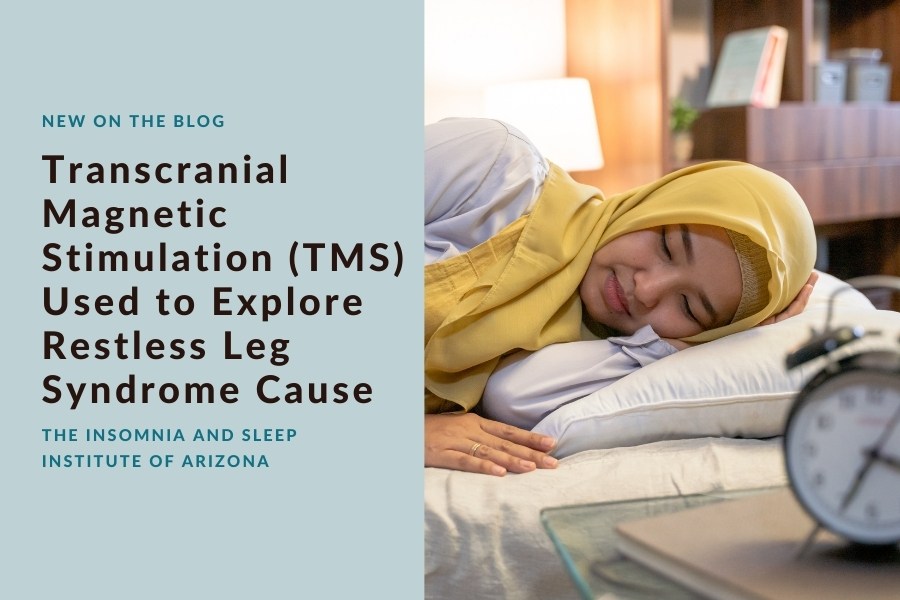Transcranial Magnetic Stimulation, or TMS, is a non-invasive brain stimulation procedure that features a shifting magnetic field. This field, in turn, generates an electric current within key parts of the brain through electromagnetic induction. TMS is now being used for a variety of mental health conditions, but is also a promising treatment for sleep disorders including insomnia and—according to recent research—possibly restless leg syndrome (RLS). The Insomnia and Sleep Institute of Arizona and TMS Institute of Arizona are committed to providing an outcome-driven approach to treatment. The Insomnia and Sleep Institute is staffed by sleep experts and home to triple board-certified “Top Doc” of the area, Dr. Ruchir P. Patel, as voted by his colleagues and peers for the past six years.
At Johns Hopkins Medicine, scientists report that the latest experiments in treating RLS have provided evidence that this disorder is caused by “excitability and hyperarousal” in the brain—specifically the motor cortex. The full report can be found in Sleep Medicine and explores better and safer means of treating RLS, which is a relatively common cause of chronic sleep deprivation. TMS is a new contender in treating RLS, and is of special interest to those with RLS who want to avoid medication and more invasive forms of treatment by using electrical or magnetic means to soothe hyperarousal during sleep.
Treating Restless Leg Syndrome
According to those with RLS, symptoms present as an urge to move the legs while resting or sleeping. This sensation can be painful or just exceedingly uncomfortable. Some with RLS describe the feeling as “worms crawling up their legs,” say researchers at Johns Hopkins. The only way to achieve relief is by standing up or moving their legs which, of course, can interrupt sleep. Although RLS in and of itself is not dangerous, long-term untreated RLS can cause chronic fatigue and all of the side effects and co-morbidities that come with lack of sleep such as anxiety and depression.
For many years, the common treatment for RLS has been medications like opioids and anti-seizure drugs. Understandably, since there is no “cure” for RLS, patients do not want to commit to a lifetime dependency on pharmaceuticals (some of which can have serious risks and side effects when used chronically). Until recently, researchers have not paid close attention to the neurological foundations of RLS as there is much debate surrounding the issue. However, Johns Hopkins researchers say that their data supports the theory that the underlying cause of RLS is that the brain is moving the legs and, as such, focusing on the brain may be the key to treatment.
Using TMS for RLS
According to one of the researchers, “Essentially the brain sends the signal when it’s preparing to move a limb, even when you aren’t planning to move, so your body is ready and amped up. The only way to alleviate the feeling is to move.” The study included 32 adults with moderate to severe RLS, all of whom underwent treatment for 12 days. In addition, 31 adults without RLS were part of a control group. Most (59 percent) were women and the average age was 58.
Scientists used TMS to safely apply pulses to parts of the brain that control movement in the leg or hand. Muscle responses were measured using both short- and long-interval pulses and ratio of responses were analyzed. The ratios were greater in those who have RLS (.36) compared to those without an RLS diagnosis (.07), but only in long-term pulses. Researchers state, “This basically means that inhibition is reduced or weakened in people with restless leg syndrome compared to people without the condition. The reduced response means that the region of the brain controlling the legs shows increased cortical excitability in the motor cortex.”
Additional testing and research are needed, but for now TMS is considered a safe and seemingly effective means of treating sleep disorders as well as mental health conditions. If you struggle with RLS or any sleep disorder, working with a sleep expert is paramount to your health and well-being. No referral is needed to schedule your consultation with The Insomnia and Sleep Institute, where you meet with a sleep specialist capable of diagnosing conditions from your first appointment onward. Contact The Insomnia and Sleep Institute today by calling the office or, for the quickest response, simply complete the online contact form.





